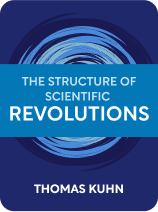

This article is an excerpt from the Shortform book guide to "The Structure Of Scientific Revolutions" by Thomas Kuhn. Shortform has the world's best summaries and analyses of books you should be reading.
Like this article? Sign up for a free trial here .
How does Kuhn explain a scientific revolution? What spurs a revolution into motion and how do we know that a scientific discipline has been revolutionized?
According to Thomas Kuhn, a scientific revolution happens when new discoveries do not fit into the existing scientific frameworks. When that happens, scientists have to break with traditional knowledge and start looking for a new model that fits this new information.
Read more about Thomas Kuhn’s scientific revolution theory.
Thomas Kuhn: Scientific Revolution
The word “revolution” is usually used in a historical context, not a scientific one. However, there are many parallels that make the term appropriate here. First of all, revolutions start with a growing feeling that the current systems aren’t working. This is often because they’re failing to solve problems they helped to create.
Revolutions, whether political or scientific, try to overthrow the current establishment and put a new one in its place. The community is inevitably divided into those defending the status quo and those fighting against it.
Once that division happens, there is no political solution. The people can’t even agree on what type of political (or in this case, scientific) framework should be in place to make that solution happen. It’s impossible to resolve the conflict by the usual methods, because those are set by the current paradigm, and it’s the paradigm itself that’s under attack. The only thing that’s clear to all sides is that the competing paradigms can’t coexist. Finally, the opposing parties use whatever means they can to get popular opinion on their own side, including force if needed.
Why Revolutionary Science Is Hard to See
According to Thomas Kuhn, a scientific revolution isn’t usually seen as a revolution at all. It is viewed as an addition to knowledge, as would be expected from normal science. Any additional examples would run into the same issue.
Part of the problem is that both scientists and laypeople get their ideas of science from authorities that methodically hide the existence of revolutions. These authorities are usually textbooks, along with popular works and philosophical treatises based on those same paradigms. All of these are devoted to established paradigms, along with the data, theories, and questions it contains.
These works explore the results of revolutions, rather than the revolutions themselves, which gives the impression that those revolutions never happened. Furthermore, they tend to show revolutionary science is just a logical progression of knowledge, rather than the overthrow of established paradigms.
This is done for practical reasons, not to deliberately cover up the facts. There’s no sense in exploring the entire history of science in every textbook, so for teaching purposes, they only cover the parts that are relevant to the current paradigm.
However, as a result, the books end up making revolutionary science look like normal science—linear progress from ignorance to knowledge through the accumulation of facts. They can also give the false impression that scientists have always been working to solve the questions posed by our modern paradigms.

———End of Preview———
Like what you just read? Read the rest of the world's best book summary and analysis of Thomas Kuhn's "The Structure Of Scientific Revolutions" at Shortform .
Here's what you'll find in our full The Structure Of Scientific Revolutions summary :
- How scientific paradigms evolve and become replaced with new paradigms
- Why science is more about figuring out what isn't right
- How throwing out past achievements allows for scientific progress






